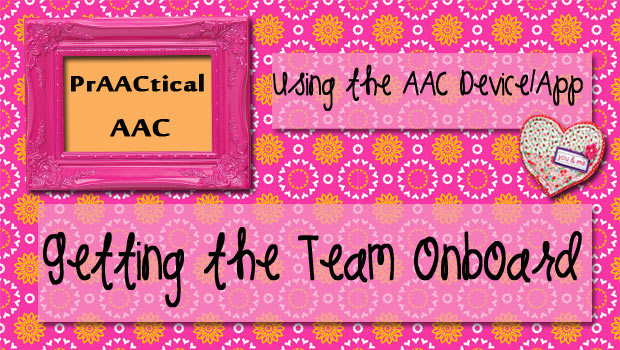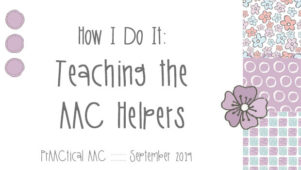Using the AAC Device/App: Getting the Team On Board

Families and professionals often share a common frustration when a new SGD, communication aid, or AAC app is introduced: Getting people to use it. Whether we’re fighting with insurance companies or navigating the educational maze, our attention is often consumed by getting access to the device. Then, oh happy day, it arrives. Round 1 is over. We won! We get it set up (no small feat). We start teaching the communicator to use it and everyone shares the excitement of this new tool. For awhile, anyway.
–
And then, reality sets in.
–
We realize that learning to communicate through this tool and building language skills with it is a p-r-o-c-e-s-s. There’s an arc to that process. It slowly sinks in that this new tool is necessary but not sufficient for real communication and language learning to occur. Though we knew that having the AAC device or app wasn’t going to be a quick fix, it’s still a bit of a downer. Round 2 is a draw: We’ve seen some immediate benefits to the new tool but have a growing awareness that now the real work begins. Aided language input is a wonderful starting point for many communication partners.
—
Aided Language Input is a great way to get the team moving in the right direction. Here are some suggestions that have worked for us.
–
1. First things first: Take the pressure off of teaching the AAC user for now. Focus the team on getting used to the new tool themselves so that they can be good interventionists in the weeks to come.
2. Set a specific goal and timeframe. “For the next 2 weeks, we’re each going to use the XYZ device/app when we talk to Johnny.” “Let’s each shoot for using it at least once in each activity.”
3. Lead by example: Use the AAC tool when talking to the learner so that others on the team see how important it is. The more they see YOU using aided language input, the more likely they will be to try it themselves.
4. Be authentic: Use aided language input to your best ability and don’t worry if, at first, you struggle. We all slip and slide a bit when learning to model use of an AAC system. Don’t let that stop you. In fact, other team members might feel more relaxed about their own less-than-perfect attempts once they’ve seen that you aren’t perfect either. The message is that we’re all in this together, learning and striving each day/session to be just a little bit better at supporting people who use AAC.
5. Recognize effort: Be generous with compliments and stingy with criticism. While it seems like the focus is on this one strategy, the real prize is building a team that constantly moves forward in building their intervention skills. Recognizing people in a genuine way is a good way to breathe a little wind into flagging sails.
6. Hold people accountable: The truth is that we are all more likely to implement things when we know that other people are checking up on us. Holding people accountable in a respectful and positive way can help create a culture of learning and mutual support. We like taking a casual approach to this: “Hey, did you have a chance to use Johnny’s communication board when you were talking to him at recess?’ ‘No, oh okay. Maybe you can try it tomorrow. I’ll stop by and see how it went.”
—
As we said before, aided language input is one of our ‘go to’ strategies for teaching language to people learning AAC. It can take some time to get used to ‘speaking AAC’ but it’s a strategy that pays big dividends.
—
You can read more about Aided Language Input as an intervention strategy on this page from the Indiana Resource Center for Autism.
—
Filed under: Strategy of the Month
Tagged With: collaboration, implementation ideas, intervention
This post was written by Carole Zangari




